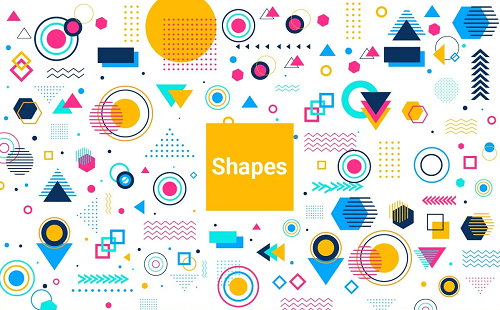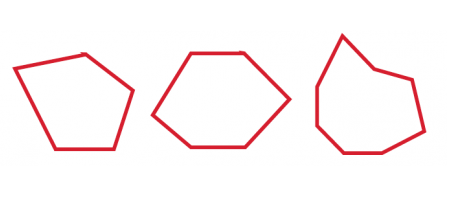
Visual communication is key in capturing the audience’s attention through content. The picture tells the whole story and keeps the viewer excited and hooked.
One of those crucial elements of graphic design that holds the key to capturing attention is shapes. Different kinds of shapes portray different meanings. This post will help you understand how shapes can make your graphic design stand out.
Types of Shapes
Shapes are one of the most important parts of any graphics design. You can use them to create logos, icons, illustrations, and infographics. Shapes are basically used to evoke emotions, create visual interest, convey a message or meaning, or even organize content.
Let’s look at different types of shapes and see how we can use them effectively in the following —
1. Geometric Shapes = These are the shapes that you can create using a ruler and compass. They are mostly accurate and in order and can bring a sense of stability and strength within you. Squares, rectangles, triangles, ovals, and circles are some of the common geometric shapes.
- Organic Shapes = Organic shapes are something that is not regular and free-flowing. These are usually found in nature and can create a sense of motion, energy, and growth. Some examples of organic shapes are clouds, trees, mountains, and flowers.
There are 2 types of organic shapes.
- Regular
- Irregular
Regular Shapes
These take the form of those naturally or regularly available in the environment, such as flying creatures, trees, rivers or streams. When applied in graphic design, natural shapes are interesting and topical. A basic shape such as a square or a round can become more dramatic if they were enhanced with flowers or leaves.

Irregular Shapes
These are not fixed in terms of any angle, side, and size. These shapes can have size and angle of any length and size. These shapes are very useful to create something that offers innovaity, contrast, and randomness in a design.
USE SHAPES IN GRAPHICS DESIGN
1. Purpose – What are you trying to achieve with the shape? Are you trying to convey some message through that? Or do you want to create something that’s visually appealing? Once you know and figure out the purpose, it becomes easy for you to choose the right shapes. The best way to understand the right usage of shapes in graphic design is by opting for top online courses.
2. Audience – Whom are you designing for? What kind of style do they like or prefer? What sort of cultural ties do they have with different shapes? For example, the color red is a symbol of love and passion in Western cultures and anger and danger in some Eastern cultures.
Here are some tips on how to use shapes in graphic design:
- Use shapes to organize and streamline your thoughts. For example, use bold and large shapes to draw focus to a particular feature in your design.
- You can create contrasting and visually appealing shapes. The contrasting colors or textures make your shapes stand out.
- Shapes can be used to convey certain emotions and messages. Let us consider that if you want to convey something that’s close to solidity and strength, then you can use geometric shapes. Similarly, if you want to express something that’s lively and energetic, then you can opt for organic shapes.
- You can also use shapes to organize the content and make it easy to read and understand. For example, you can use a certain shape as an infographic where you’ll find lots of important information organized and easy to read.
The Psychology of Shapes
As discussed earlier, different shapes and different emotions in a viewer. In this section, we will look at all the most used shapes in graphic design and see which shape evokes what kind of emotion.
- Squares: Strength, stability, order, reliability
- Rectangles: Efficiency, organization, professionalism
- Triangles: Movement, dynamism, excitement
- Circles: Unity, harmony, wholeness
- Ovals: Femininity, sweetness, grace
- Clouds: Softness, lightness, dreaminess
- Mountains: Strength, stability, grandeur
- Trees: Growth, life, nature
- Flowers: Beauty, femininity, fragility
If you are designing a logo for a tech company, you would ideally want to design a logo using geometric shapes like squares and rectangles. The reason for that is these two symbols showcase stability and how reliable the company is.
Similarly, if you are designing for a toy company, you would ideally want to use organic shapes. Shapes like circles and ovals convey a sense of excitement and happiness.
Abstract Shapes :- These shapes (often referred to as conceptual shapes), despite being designed in bizarre language, is universally acceptable by the audience.


[…] requires considering color, typography, white space balance, images, placement, and navigation. shape graphics in creating visually compelling […]
[…] games are also the parts of graphic and illustration. In the games we can see that many types of graphics and illustrations are used to […]
[…] Style :- Graphic design campaign can change up the style of their lines by adjusting the length, width, weight, texture, and […]
[…] “graphic design” is a relatively recent concept. The first recorded usage of the term was in a 1908 San Francisco educational trade manual for printers and a 1918 California School of Arts and … advertisement for a course on “Graphic Design and […]
[…] you will do is establish your icon’s form or basic shape to ensure a solid foundation. The basic shapes are circles, squares, ellipses, triangles, and other geometric […]